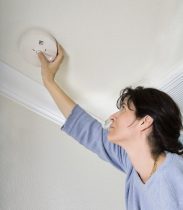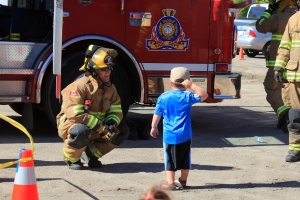Fire Prevention Week takes place in October every year. Fire Prevention Week has been observed since 1922. It is sponsored by the National Fire Protection Association and its purpose is to educate the public about the importance of fire prevention. This is a perfect time for families to discuss fire safety issues and to prepare for fire emergencies. Discuss the following talking points with your family to reduce the risk of injury to all of you in the event of a fire.
- Stay low in smoke. The smoke can warn you about a fire, but breathing it can make you sick. Since smoke rises, teach your children to stay close to the floor if they smell smoke. Practice crawling low toward the exit. It’s important to exit the building quickly. If crawling will take too long, teach your child to stay as low to the floor as possible while walking quickly to the exit.
- Stop, Drop, and Roll. Educate your family about what to do if their clothes catch fire. Children must stop running, drop to the ground, cover their faces with their hands, and roll from one side to the other until the fire is out. As children practice this technique, remind them to lie as flat on the ground as possible as they roll. The ground will smother the flames out.
- Maintain Fire Protection Tools. Make sure there is at least one smoke detector on each level of your home. Install one near each sleeping area. Check that they are working properly by
 pressing the test button. A good time to do this is on the first of every month. If your smoke detectors require batteries, replace them on the first of every year. Smoke detectors should be updated every ten years. You should also have fire extinguishers in your home. They can be used to put out small fires that are contained and not growing. If the fire is growing or if the smoke is thick, exit the building immediately. Your safety must be priority.
pressing the test button. A good time to do this is on the first of every month. If your smoke detectors require batteries, replace them on the first of every year. Smoke detectors should be updated every ten years. You should also have fire extinguishers in your home. They can be used to put out small fires that are contained and not growing. If the fire is growing or if the smoke is thick, exit the building immediately. Your safety must be priority.
- Have a Plan. Decide how you will exit your home in the event of an emergency. It is best to have two routes. Designate a meeting place outdoors. Practice your fire escape plan on a regular basis.
- Think Like a Child. Look around your home, and eliminate any potential dangers that your children may encounter. Explain that matches, lighters, stoves, etc. are tools for adults only. Children should stay away from such things and tell an adult if they find them.
 Go to the Firefighters. Children have been known to hide from firefighters in a rescue situation. They were frightened by the mask and other safety gear the firefighter was wearing. Show your children what firefighters might look like when they are dressed in their safety gear. Remind them that the firefighters are there to help!
Go to the Firefighters. Children have been known to hide from firefighters in a rescue situation. They were frightened by the mask and other safety gear the firefighter was wearing. Show your children what firefighters might look like when they are dressed in their safety gear. Remind them that the firefighters are there to help!
Fires are scary, but it is important to talk about them. Also, keep in mind that practice is important – young children learn best through repetition. Explain to children that they will be safe if they are ever in a fire because they know exactly what to do! Regular discussion will help ease children’s fears.
For more information, visit the National Fire Protection Association’s web site at nfpa.org. Your children might enjoy browsing sparky.org, a web site for kids.
Back to blog listing